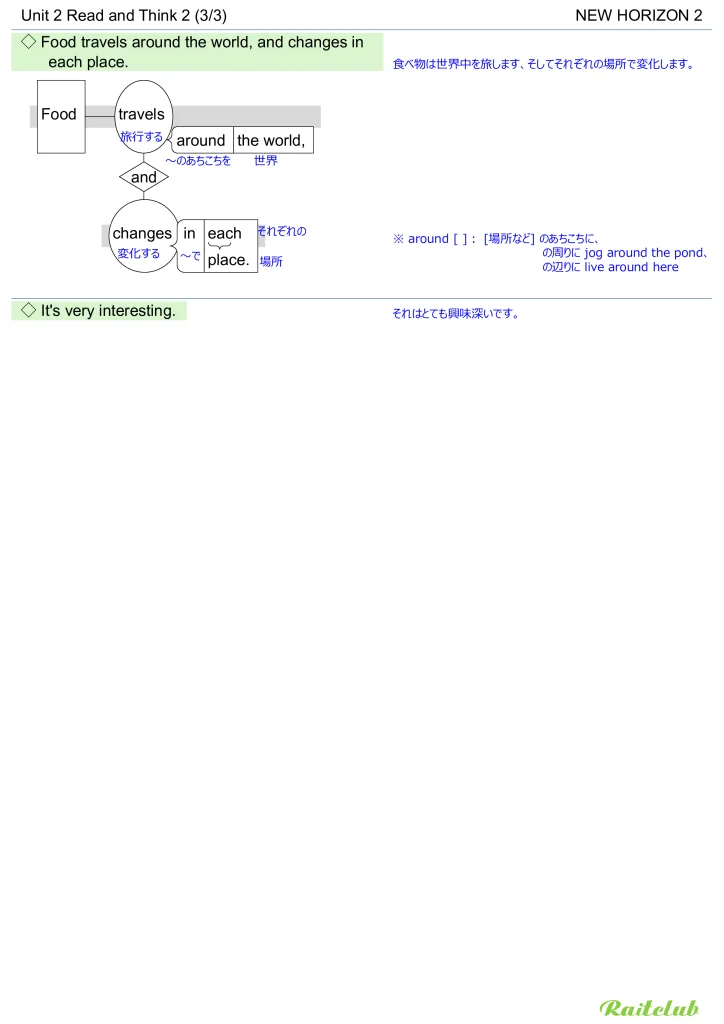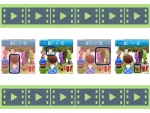中学2年生教科書 New Horizon 2 (ニューホライズン 2年) Unit 2:Food Travels around the World の重要文法と、本文・和訳・英文見える化チャートです。
英文見える化チャートは、英語の「意味理解」を視覚的にサポートするツールです。習得を促進する音声付きです。音読活動などで活用することで英語を身に着けるのを支援します。
ポイント解説付きなので、定期テスト対策として、単語の意味・用法や、文法・文構造の確認にも使えます。
なおこのページでは英語のみの音声も聞けます。リスニングやシャドウイングなどでお使いいただけます。
重要文法
接続詞 when < When + (A) + , + (B)>
{時間情報を加える} (A) のときに (B)
*< (B) + when + (A)>も同じ意味(コンマ (,)不要)
➡ When I go overseas, I take many pictures.
接続詞 if < If + (A) + , + (B)>
{条件を表す} (A) ならば (B)
*< (B) + if + (A)>も同じ意味(コンマ (,)不要)
➡ If you are free, please help me.
接続詞 that < 動詞 + that + (節)>
{考え・発言など} (節)ということを~する
*動詞は think, sayなど
*that はしばしば省略される
➡ Ken knows that the restaurant is good.
接続詞 because < Because + (A) + , + (B)>
{理由を表す} (A) だから (B)
*< (B) + because + (A)>も同じ意味(コンマ (,)不要)
➡ I like Mt. Fuji because it’s beautiful.
本文・和訳・チャート
音声リスト
※ バックグラウンド再生もできます
以下の各パート内の音声は速度調整や個別にループ再生もできます
Unit 2 Scene 1
◇ I like cooking.
私は料理をすることが好きです。
※ 動詞を “…ing” の形にすると、「…すること」の意味になる {動名詞}
◆ When I watch TV, I see many interesting dishes.
私はテレビを見るときに、多くの興味深い料理を見ます。
◆ 接続詞 when < When + (節A) + , + (節B)>
{時間情報を加える} (節A)のときに(節B)
< (節B) + when + (節A)> も同じ意味 *コンマ (,)不要
※ 節: 主語と動詞を含んだ単語のかたまり(文のようなもの)
※ watch: {注目して一定の時間} ~を見る; {事故などに遭わないよう} ~に注意する watch your head
※ see: {気付く・わかる} ~が見える、~を見る; ~を知る、理解する; ~に会う
◇ There are many kinds of curry recipes in Japan: curry and rice, curry pilaf, curry noodles, and even curry bread.
日本には多くの種類のカレーの調理法がありますーカレーライス、カレーピラフ、カレーヌードル、カレーパンでさえ。
※ コロン( : )は項目の一覧、同格、補足説明などを導く時に使う
※ many kinds of ~: 多くの種類の~
a kind of ~: ある(ひとつの)種類の~ → ~の一種
※ of [ ]: [言及している量・種類の対象] の a lot of dishes ★ 追加説明 ~の
※ even: {驚くべきことなのを強調して} でさえ
◆ I never heard of curry bread when I was in the Philippines.
私がフィリピンにいたときに、私はカレーパンのことを一度も聞きませんでした。
※ never: 今まで一度も~しない
※ hear of ~: ~について聞く、情報を得る
※ of [ ]: [主題] の、についての ★ 追加説明 ~の
◇ It’s interesting.
それは興味深いです。
音声(英語/習得用)
| ♪ 英語の音声: | |
| 1回再生 | |
|---|---|
| ループ再生 | |
| ♪ 習得用の音声(英⇒日を区切りごと): | |
| 1回再生 | |
|---|---|
| ループ再生 | |
英文見える化チャート 1/2
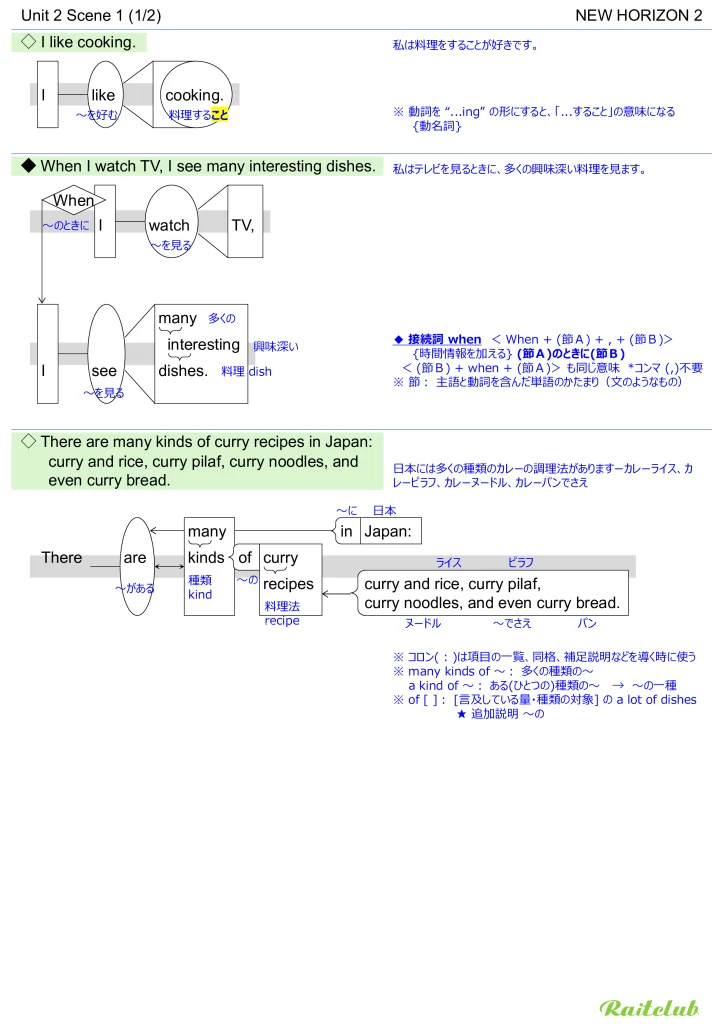
英文見える化チャート 2/2
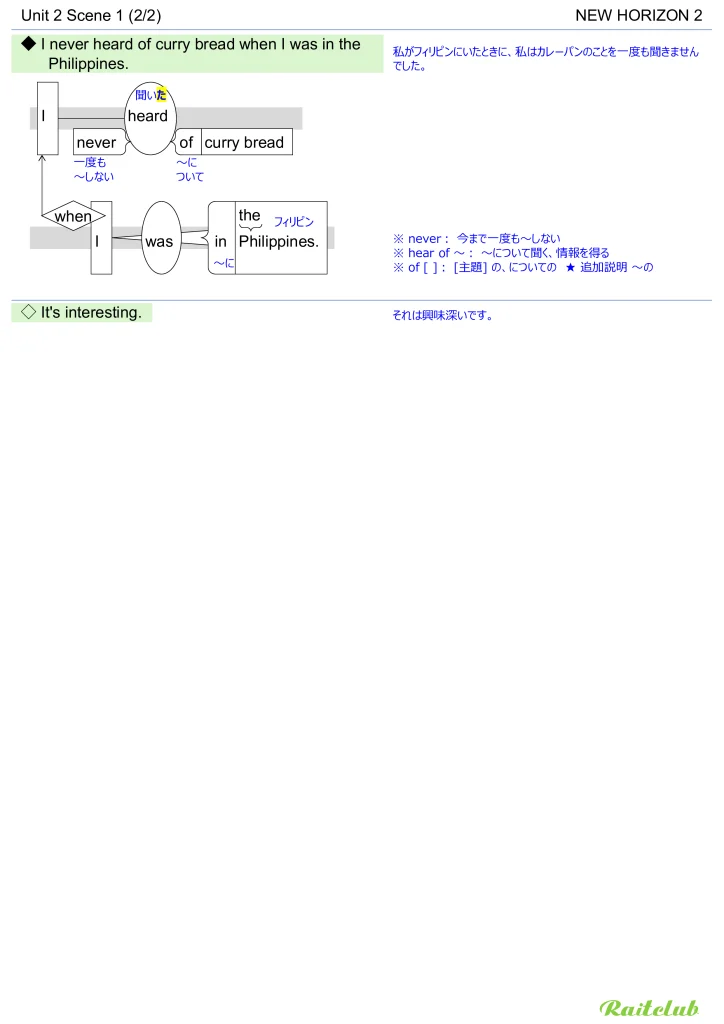
Unit 2 Scene 2
◇ There’s a good curry restaurant near my house.
私の家の近くに、いいカレー・レストランがあります。
◇ Really? I want to go there sometime.
本当に? 私はいつかそこへ行きたいです。
◇ Meg and Kaito will go there this Sunday.
メグとかいとは、この日曜日にそこへ行きます。
※ 助動詞 will < will + 動詞の原形>
{未来*のことを言う時} ~します、~でしょう
* 確実なこと、予測、意向(その場で決めた) など
◆ If you have time, we can go with them.
あなたが時間があれば、私たちは彼らと一緒に行くことができます。
◆ 接続詞 if < If + (節A) + , + (節B)>
{条件を表す} (節A)ならば(節B)
< (節B) + if + (節A)> も同じ意味 * コンマ (,)は不要
◇ Great! I want to eat curry pilaf.
すばらしい。 私はカレーピラフを食べたいです。
◇ Sounds good.
(それは)よさそうに聞こえます。 → いいですね。
※ sound + 形容詞など: 「~に聞こえる」と聴覚的な判断を表す。 主語=形容詞、とbe動詞文に似ているが、疑問文の作り方などは一般動詞と同じ
参考)look + 形容詞など: 「~に見える」
◇ You know, curry and rice originally came to Japan from overseas.
ほら、カレーライスはもともとは、海外から日本へ来ました。
※ you know: 言う内容を強調する時、相手の理解を期待する時、次の言葉が出ない時などに使う
◇ From India, right?
インドから、そうですよね。
◇ Well, you’re half right.
ええと、あなたは半分正しいです。
◇ What do you mean?
あなたは何を意味していますか。 → どういう意味ですか。
◆ Read this book if you’re interested in the other half.
あなたが別の半分に興味があるならば、この本を読んでください。
※ in [ ]: [テーマ・分野など] に関して
※ the other: {状況から特定できる} 他の → 残りの全てを指す
音声(英語/習得用)
| ♪ 英語の音声: | |
| 1回再生 | |
|---|---|
| ループ再生 | |
| ♪ 習得用の音声(英⇒日を区切りごと): | |
| 1回再生 | |
|---|---|
| ループ再生 | |
英文見える化チャート 1/2
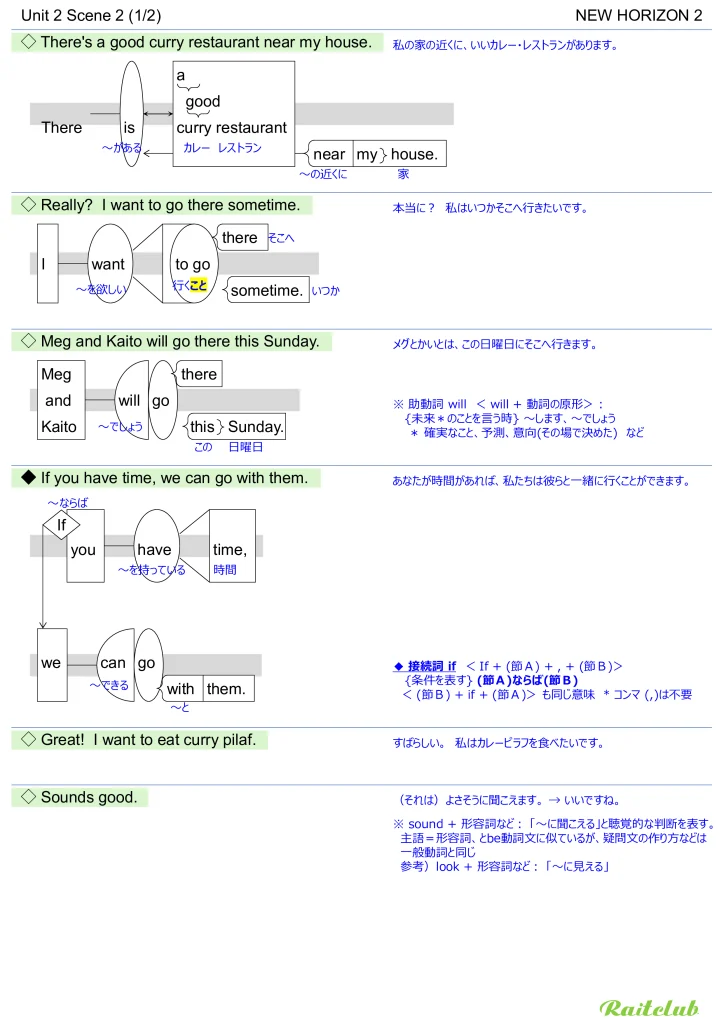
英文見える化チャート 2/2
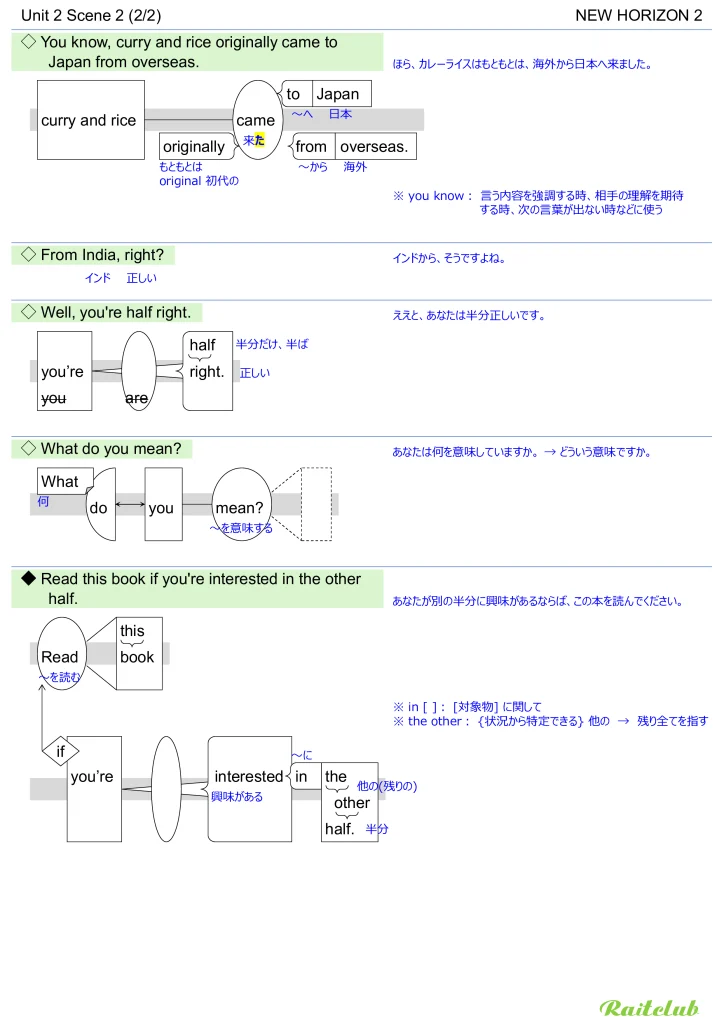
Unit 2 Read and Think 1
◆ Many people think curry came to Japan directly from India.
多くの人々はカレーがインドから直接、日本へ来たと思っています。
◆ 接続詞 that < 動詞 + that + (節)>
{考え・発言など} (節)ということを~する * 動詞は think, sayなど
that はしばしば省略される
◆ But do you know that it really came from the U.K.?
しかしそれは本当はイギリスから来たことをあなたは知っていますか。
◇ In the 18th century, special curry spices came to the U.K. from India, and curry became popular.
18世紀に特別なカレーのスパイスがインドからイギリスに来て、そしてカレーは人気になりました。
※ the: {世紀や年代を指す時} the 1900s, the 80s ★ 特定できるもの
※ became: become の過去形
◇ Later, a British company produced curry powder for sale.
その後、(ある)イギリスの会社が販売用のカレーの粉を製造しました。
※ for sale: 売るための
※ for [ ]:[動作や物の目的] のための ★ 方向 ~のため
※ a: {人・物(単体)の一般名・種類を言う時} {初めて言及する単体を指す時} ★ 実物を特定しない単体
◇ The cooking of curry became easy.
カレーの調理は簡単になりました。
※ the: {特定の動作(後から特定)を指す時} ★ 特定できるもの
※ of [ ]: [言及している動作の対象] の ★ 追加説明 ~の
◇ In the 19th century, this curry arrived in Japan.
19世紀にこのカレーが日本国内に到着しました。
◇ Japanese chefs put flour in the curry, and it became thick.
日本の料理人はそのカレーに小麦粉を入れ、そしてそれは濃くなりました。
※ put: put の過去形
◇ They also used big pieces of potatoes, onions, and carrots.
彼らはまた、ジャガイモ、タマネギ、そしてニンジンの大きなピース(切り分けたもの)を使いました。
◇ Then they put it on rice.
それから彼らはそれをライスの上にのせました。
◇ This became the Japanese “curry and rice.”
これが日本の「カレーライス」になりました。
音声(英語/習得用)
| ♪ 英語の音声: | |
| 1回再生 | |
|---|---|
| ループ再生 | |
| ♪ 習得用の音声(英⇒日を区切りごと): | |
| 1回再生 | |
|---|---|
| ループ再生 | |
英文見える化チャート 1/3
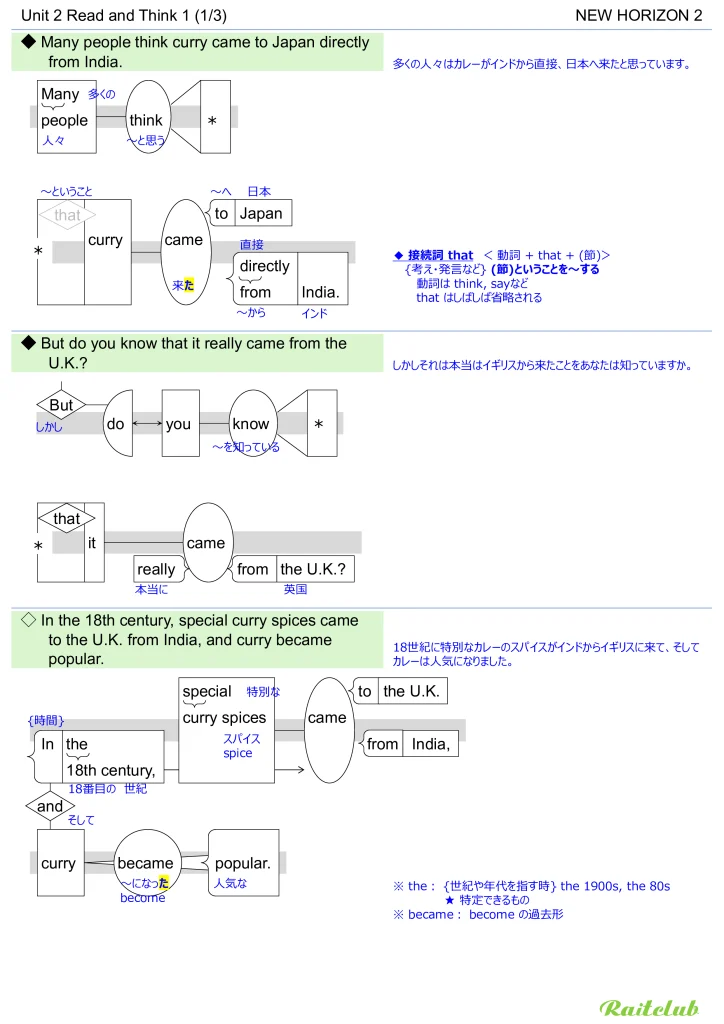
英文見える化チャート 2/3
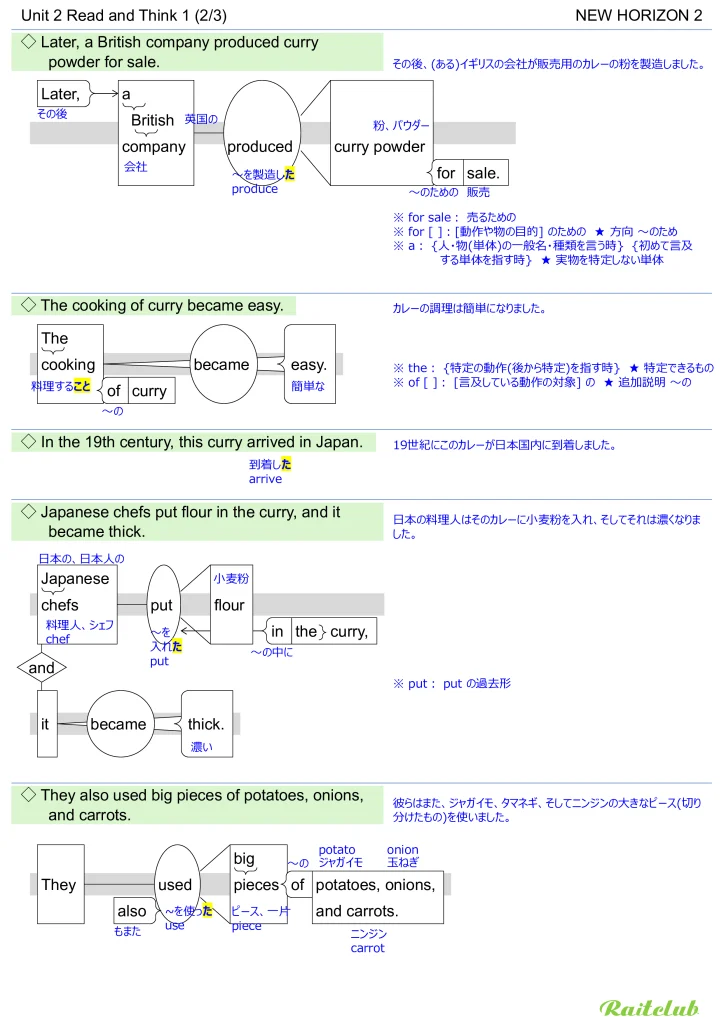
英文見える化チャート 3/3
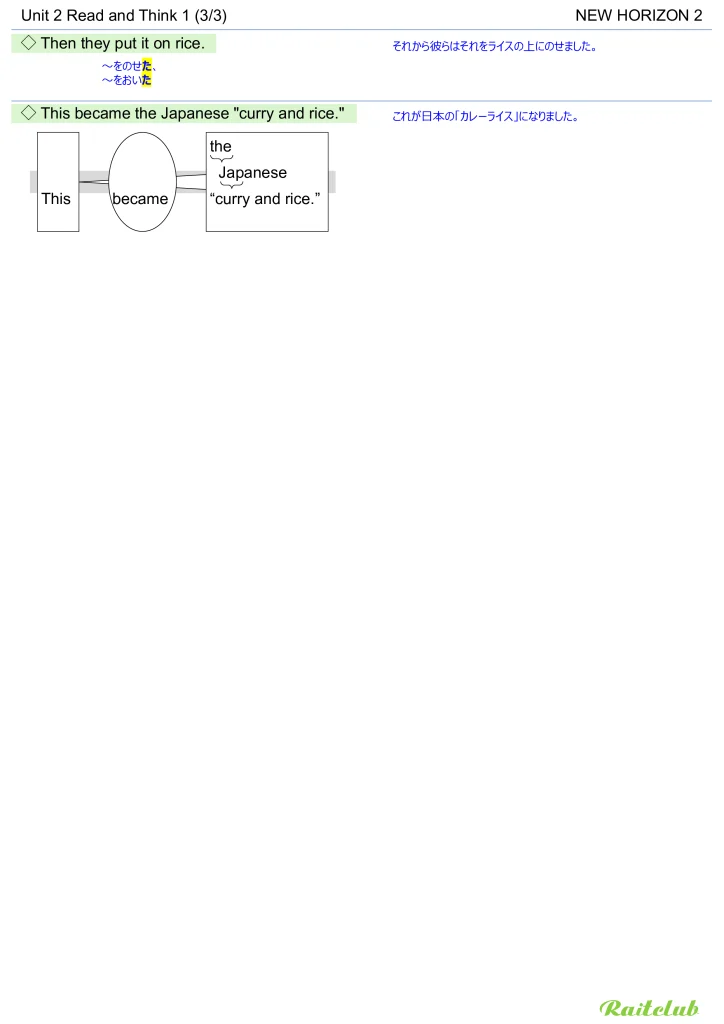
Unit 2 Read and Think 2
◇ “Curry and rice” is one blend of different food cultures.
「カレーライス」は異なる食文化のひとつのブレンド(混ぜたもの)です。
◇ Here are some others.
ここにいくつかの他のもの(ブレンド)があります。
※ here is/are ~: 人に何かを見せる時の表現
主語や動詞などの位置が入れ替わっている文(倒置)
◇ Spaghetti comes from Italy, but a Japanese chef created “spaghetti Napolitan” in Japan.
スパゲティーはイタリアから来ています、しかしある日本の料理人が日本で「スパゲティー・ナポリタン」を創作しました。
◇ He made it with a special tomato souce and named the dish “Napolitan” after Naples in Italy.
彼は特別なトマトソースでそれを作り、イタリアのナポリにちなんでその料理を「ナポリタン」と名付けました。
※ with [ ]: [道具] で [同伴者・物] と ★ 付帯 ~といっしょに
※ name A B: A を B と名付ける
参考)call A B: A を B と呼ぶ
※ name A after D: DにちなんでAを名付ける
◇ California rolls come from the U.S.
カリフォルニア・ロールはアメリカから来ています。
◆ For many years, sushi wasn’t popular in the U.S. because people there didn’t usually eat raw fish.
何年もの間、すしはアメリカで人気がありませんでした、なぜならそこの人々は生の魚を普段は食べなかったからです。
◆ 接続詞 because < Because + (節A) + , + (節B)>
{理由を表す} (節A)だから(節B)
< (節B) + because + (節A)> も同じ意味 * コンマ (,)は不要
※ for [ ]: [時間・期間] の間
◇ So some Japanese chefs used avocado.
なので何人かの日本の料理人はアボカドを使いました。
◆ Also, they wrapped the rice on the outside because many people didn’t like seaweed.
さらに、彼らはご飯を外側の上(表面)に巻きました、なぜなら多くの人々は海藻を好きではなかったからです。
◇ Food travels around the world, and changes in each place.
食べ物は世界中を旅します、そしてそれぞれの場所で変化します。
※ around [ ]: [場所など] のあちこちに、の周りに jog around the pond、の辺りに live around here
◇ It’s very interesting.
それはとても興味深いです。
音声(英語/習得用)
| ♪ 英語の音声: | |
| 1回再生 | |
|---|---|
| ループ再生 | |
| ♪ 習得用の音声(英⇒日を区切りごと): | |
| 1回再生 | |
|---|---|
| ループ再生 | |
英文見える化チャート 1/3
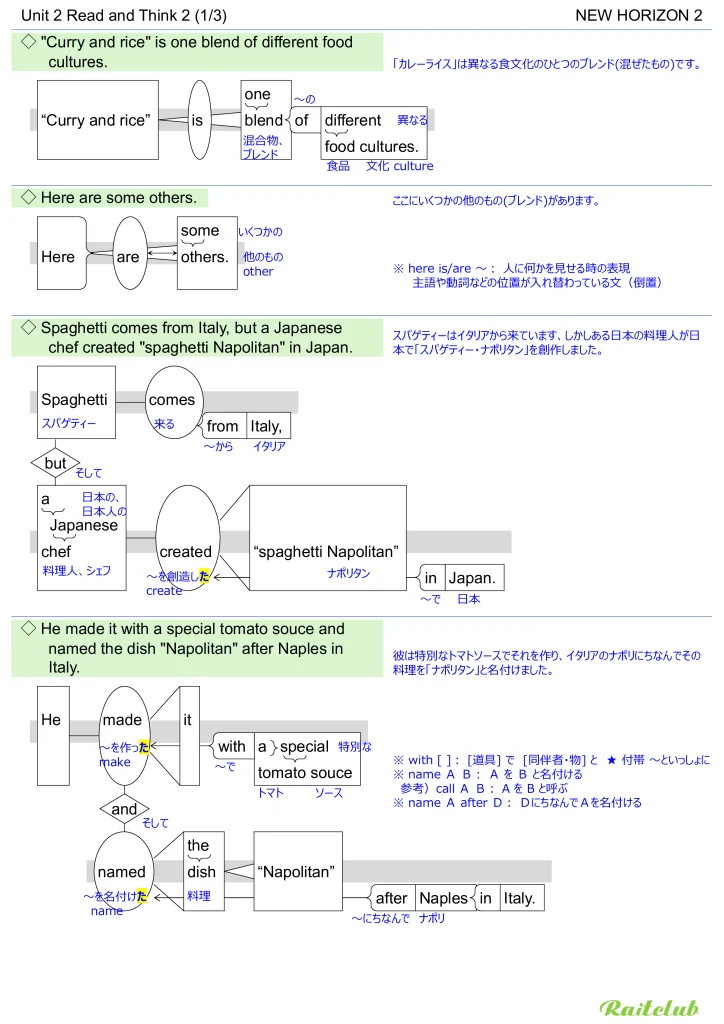
英文見える化チャート 2/3
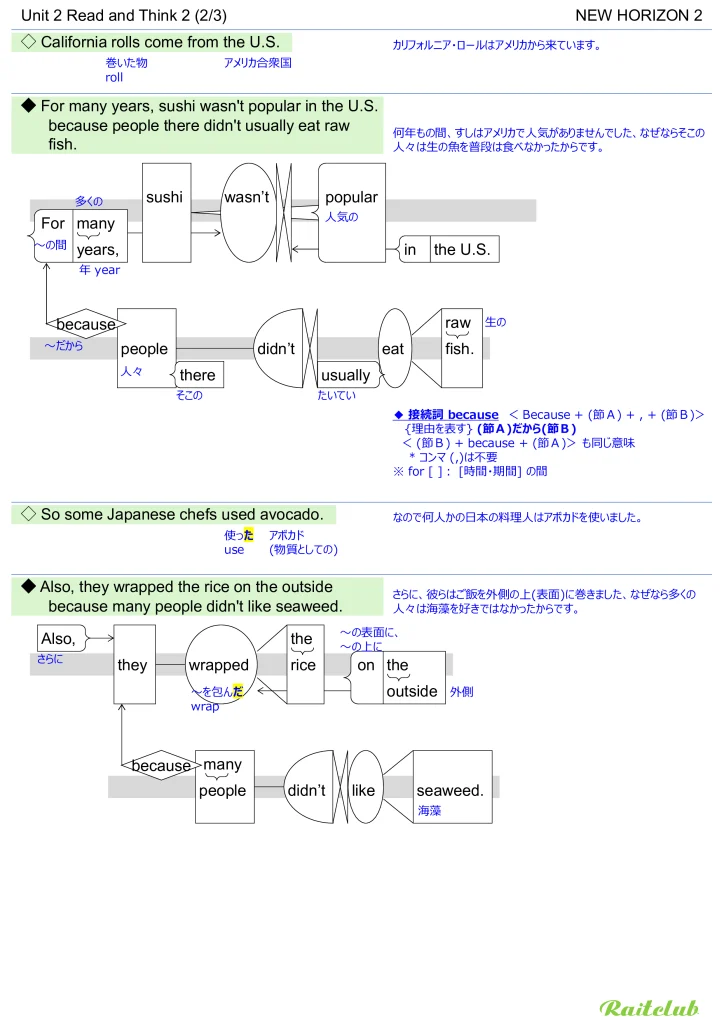
英文見える化チャート 3/3
